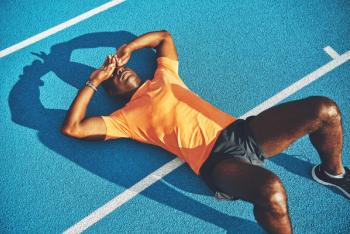
- Vol 42, Issue 8
Psychiatry and Spirituality: Exploring the Intersections of Meaning and Mental Health
Key Takeaways
- Spirituality, distinct from religiosity, is crucial in psychiatric care, enhancing therapeutic outcomes and addressing existential concerns.
- Neuroscience and spirituality convergence offers insights into neural mechanisms, suggesting innovative therapeutic interventions for mental health.
In this CME, learn about the convergence of neuroscience and spirituality.
CATEGORY 1 CME
Premiere Date: August 20, 2025
Expiration Date: February 20, 2027
This activity offers CE credits for:
1. Physicians (CME)
2. Other
All other clinicians either will receive a CME Attendance Certificate or may choose any of the types of CE credit being offered.
ACTIVITY GOAL
To inform readers of how to integrate spirituality into clinical care in order to improve mental health outcomes.
LEARNING OBJECTIVES
1. Learn about the convergence of neuroscience and spirituality, which presents a compelling framework for exploring the biological foundations of spiritual experiences and their implications for mental health.
2. Learn how to utilize the terror management theory.
TARGET AUDIENCE
This accredited continuing education (CE) activity is intended for psychiatrists, psychologists, primary care physicians, physician assistants, nurse practitioners, and other health care professionals who seek to improve their care for patients with mental health disorders.
ACCREDITATION/CREDIT DESIGNATION/FINANCIAL SUPPORT
This activity has been planned and implemented in accordance with the accreditation requirements and policies of the Accreditation Council for Continuing Medical Education (ACCME) through the joint providership of Physicians’ Education Resource®, LLC and Psychiatric Times. Physicians’ Education Resource, LLC is accredited by the ACCME to provide continuing medical education for physicians.
Physicians’ Education Resource, LLC designates this enduring material for a maximum of 1.5 AMA PRA Category 1 Credits.™ Physicians should claim only the credit commensurate with the extent of their participation in the activity.
This activity is funded entirely by Physicians’ Education Resource, LLC. No commercial support was received.
OFF-LABEL DISCLOSURE/DISCLAIMER
This accredited CE activity may or may not discuss investigational, unapproved, or off-label use of drugs. Participants are advised to consult prescribing information for any products discussed. The information provided in this accredited CE activity is for continuing medical education purposes only and is not meant to substitute for the independent clinical judgment of a physician relative to diagnostic or treatment options for a specific patient’s medical condition. The opinions expressed in the content are solely those of the individual faculty members and do not reflect those of Physicians’ Education Resource, LLC.
FACULTY, STAFF, AND PLANNERS’ DISCLOSURES AND CONFLICT OF INTEREST MITIGATION
None of the staff of Physicians’ Education Resource, LLC or Psychiatric Times or the planners or the authors of this educational activity have relevant financial relationship(s) to disclose with ineligible companies whose primary business is producing, marketing, selling, reselling, or distributing health care products used by or on patients.
For content-related questions, email us at
HOW TO CLAIM CREDIT
Once you have read the article, please use the following URL to evaluate and request credit:
Spirituality, often defined as the search for meaning and connection beyond the self, is a fundamental dimension of human experience that has been historically overlooked in psychiatric practice. (However, recent editions of the DSM have acknowledged the relevance of religious and spiritual aspects in clinical practice. The inclusion of “Religious or Spiritual Problem” [V62.89] acknowledges that such concerns may warrant clinical attention, even though they do not constitute a mental disorder. This designation emphasizes the importance of addressing these issues within the cultural context of the patient’s identity, faith, and values.) Traditional psychiatric models have primarily focused on symptom management and functional restoration, often neglecting deeper existential concerns that can significantly impact mental health. However, emerging evidence suggests that integrating spirituality into psychiatric care can enhance therapeutic outcomes and promote holistic healing.
Although spirituality is often associated with religiosity, it is important to distinguish between the 2 concepts. Religiosity is characterized by specific beliefs, practices, and commitments to organized religions. It often involves adherence to doctrines, rituals, and a structured approach to worship that nurtures a sense of belonging within a group. Religious communities serve as vital support networks, alleviating feelings of isolation and loneliness through shared beliefs and social interactions.
Conversely, spirituality presents as a more individualized journey, focusing on the search for meaning and purpose. It transcends the confines of religious frameworks, allowing for a broader exploration of personal beliefs and experiences. While spirituality may include elements associated with religion, such as a connection to a higher power or an existential understanding of existence, it ultimately emphasizes individual interpretation and personal growth.
The relevance of spirituality in psychiatry is particularly evident in several DSM-5 diagnoses, as many patients with psychiatric disorders grapple with existential questions about suffering, mortality, and purpose. For example, individuals with persistent depressive disorders often experience guilt, existential hopelessness, and loss of faith—where a belief in a higher power or a renewed sense of purpose can serve as a source of hope.1 Similarly, those with prolonged grief disorder may find comfort in spiritual beliefs about an afterlife, which can facilitate alleged connections with deceased loved ones and provide a structured approach to processing grief through prayer or ritual. Spirituality also plays a critical role in the psychological and psychiatric support of patients with terminal illnesses coping with pain and fear related to their mortality.
The intersection of spirituality and
Recognizing spirituality as an essential component of holistic care encourages clinicians to explore its role in their patients’ health and mental health journeys. Integrating discussions on spirituality in therapy can help individuals articulate their beliefs and values, facilitating deeper self-understanding and connections with others. This facilitates meaning-making and supports posttraumatic growth by empowering individuals to reframe their experiences in ways that promote healing and resilience.3
Meaning and Existential Well-Being: Lessons From Spiritual Experiences
The intricate relationship between meaning and psychiatric disorders is essential for understanding mental health and well-being. Researchers have examined the link between existential distress and spiritual growth and how this dynamic can either foster or hinder well-being.4-6 Studies indicate, for example, that a strong sense of meaning is associated with greater life satisfaction and happiness, as well as with lower levels of psychological distress and depression.7,8
This quest for meaning is deeply influenced by the contemplation of mortality and how individuals address death and dying. An individual’s perception of mortality can significantly impact self-esteem, agency, interpersonal relationships, and spiritual well-being—all of which contribute to an overall sense of meaning.9 Importantly, mortality awareness can have both negative and positive consequences, depending on how individuals approach death: whether driven by fear and denial or by a willingness to confront and accept mortality.
When driven by fear and denial—generated by the knowledge of one’s inevitable death— individuals seek meaning and security by embracing what cannot die, such as religious beliefs, social values, and personal legacies.10 This approach, known as terror management theory, suggests that individuals cling to cultural worldviews that are imbued with value and that become abstract or symbolic representations of the self, with the promise that these worldviews can provide a sense of meaning and order in an often chaotic existence.
Central to terror management theory’s framework is the understanding that these worldviews, dimensions of which include religion, serve as psychological buffers against the distress that comes from the awareness of death. By internalizing worldviews and living up to their expectations, individuals gain self-esteem and a sense of belonging within their communities.11 Individuals engaged in this fear/denial–based process can become quite defensive and biased in their thinking about themselves and others, as they can view any threat to an existing worldview (ie, a religion different from theirs) as existentially damaging.
However, awareness of mortality does not necessarily lead to defensiveness and bias. An alternative model developed by Cozzolino et al,12 inspired by research on near-death experiences13 and posttraumatic growth,14 suggests that confronting mortality directly—rather than denying it—can help individuals integrate it into their understanding of life. This, in turn, may lessen the influence of societal expectations and obligations, allowing individuals to take a more active role in shaping their own lives.
This more open and approach-oriented reflection on death has been linked to increased self-reported spirituality,15 a greater motivation to integrate conflicting aspects of identity into a coherent self-concept,16 and higher body satisfaction among young adult women who value beauty.17 Additionally, such an attitude has been associated with enhanced gratitude,18 greater existential well-being—including reduced fear of death19—and increased internal motivation, which is independent of external influences.20
The Convergence Between Neuroscience and Spirituality
The convergence of neuroscience and spirituality presents a compelling framework for exploring the biological foundations of spiritual experiences and their implications for mental health. As this interdisciplinary field evolves, it offers insights into the neural mechanisms that shape spiritual experiences, potentially paving the way for innovative therapeutic interventions in clinical settings.
Recent neuroimaging studies have shed light on the complex relationship between specific brain regions and spiritual experiences, highlighting the medial frontal cortex; orbitofrontal cortex; precuneus; posterior cingulate cortex; and, notably, the default mode network.21-23 The default mode network—a subset of regions that are functionally connected when individuals are left undisturbed and not engaged in any externally oriented task—is widely recognized as the neural substrate of the self.24 This network is implicated in self-referential thought25 and plays a crucial role in providing us with a sense of continuity across time.26
The relevance of the default mode network extends beyond the realm of spiritual experiences. A growing body of literature has identified its dysfunction in various psychological disorders, including
Moreover, spirituality has been closely linked to the modulation of the salience network,22 a large-scale network that is primarily composed of the anterior insula and the anterior cingulate cortex. This network plays a vital role in integrating sensory, emotional, and cognitive information, thereby facilitating essential functions such as communication, social behavior, and self-awareness.31
Spiritual practices are posited to enhance an individual’s capacity for emotional regulation and interpersonal connectivity, which may provide pathways to improved mental health outcomes. This is particularly relevant given that disruptions in the salience network have been implicated in stress-related disorders, highlighting the potential of spiritual engagement as a therapeutic intervention.
Integrating Spiritual Care into Clinical Practice
Despite some patients’ desire to share their spiritual perspectives with health care providers, spirituality discussions are frequently overlooked in clinical settings.32 A key reason for this is physicians’ discomfort in addressing differing beliefs, compounded by time constraints.33,34 However, the most significant barrier is the lack of training in spiritual care, underscoring the need for targeted educational initiatives that equip clinicians with the skills and confidence to navigate these discussions.33
By acknowledging patients’ spiritual lives, clinicians can cultivate trust and support holistic, compassionate care. This acknowledgment not only strengthens therapeutic relationships but also empowers patients on their journey toward healing and self-discovery. Additionally, it strengthens doctor-patient relationships and enhances clinicians’ understanding of how patients’ spiritual beliefs may influence their treatment decisions.32,34,35
One effective method for facilitating these discussions is the adoption of structured spiritual assessments, such as the Faith, Importance, Community, Address (FICA) Spiritual History Tool. The FICA Spiritual History Tool was created by Christina Puchalski, MD, in 1996, in collaboration with 3 primary care physicians (Daniel Sulmasy, MD, PhD; Joan Teno, MD, MS; and Dale Matthews, MD, FACP), and provides a way for the clinician to efficiently integrate open-ended questions into a standard medical history to be used by health care professionals. It is a straightforward framework for clinicians to explore patients’ faith, the significance of their spiritual beliefs, their involvement in spiritual communities, and their preferences for addressing spirituality in care.36
Therapeutic modalities that explicitly incorporate spirituality—including meaning-centered psychotherapy, acceptance and commitment therapy, and mindfulness-based interventions37—can significantly improve patient outcomes and well-being. Meaning-centered psychotherapy, originally developed for patients with advanced stages of cancer, encourages individuals to engage with existential questions related to their life purpose, attitudes, and legacy, which can alleviate depressive symptoms by cultivating a sense of purpose.38,39
One of the standard meaning-centered
Acceptance and commitment therapy is a therapeutic approach that focuses on the psychological processes underlying patients’ distress and that aims to expand their psychological flexibility.41 Rather than prescribing a fixed set of techniques, this approach provides a framework for addressing various struggles, including those related to one’s spirituality, and incorporates elements from spiritual traditions.42 Its core principles include fostering open acceptance of one’s emotions and thoughts, including those related to mortality, being mindfully present as life unfolds, transcending thoughts and emotions, and committing to actions that align with one’s values.41
The psychological flexibility cultivated by acceptance and commitment therapy practices has led to improved job performance and improved pain management among chronic pain patients.41 Additionally, it can greatly alleviate individuals’ spiritual struggles, which involve conflicts and doubts stemming from their beliefs and sense of purpose in life.42 For example, a patient questioning their faith while experiencing a terminal illness can benefit from this therapy by learning to accept these doubts as part of their experience, rather than viewing them as a failure of their spirituality. Someone struggling with grief over the loss of a loved one may also benefit from this practice by acknowledging the pain and uncertainty of the loss while committing to actions that honor the deceased’s memory in ways aligned with their values. These approaches recognize spirituality not only as a resource for healing but also as a crucial element of personal growth and well-being.
Mindfulness-based interventions, such as mindfulness-based stress reduction and mindfulness-based cognitive therapy, incorporate elements of both Eastern spiritual traditions and contemporary psychological practices. Mindfulness encourages individuals to remain present in the moment, encouraging awareness and acceptance of their thoughts, emotions, and bodily sensations. The spiritual dimensions of mindfulness—nonattachment, compassion, and equanimity—can provide individuals with a sense of inner peace, even amidst external challenges. These practices have been widely shown to reduce pain, stress, anxiety, and depression, and help in the treatment of substance use disorders.37
Concluding Thoughts
With approximately 80% of Americans identifying as spiritual and/or religious (including 22% who identify as spiritual but not religious),43 psychiatric professionals need to prioritize discussions about spirituality in clinical settings. Integrating spirituality into therapy provides individuals with a space to explore their beliefs and values, cultivating greater self-awareness and strengthening interpersonal connections.
By confronting the realities of death head-on, rather than shying away from it, individuals can achieve a more profound engagement with their search for meaning, ultimately empowering them to address existential concerns with greater autonomy and personal growth. This conscious awareness of mortality not only enriches one’s sense of purpose but also promotes resilience in navigating life’s inherent uncertainties. Importantly, such engagement is a core component of various therapeutic modalities that intertwine spirituality.
Collectively, research data suggest that spiritual practices can have a notable impact on mental health outcomes, with the intersection of neuroscience and spirituality offering a promising avenue for exploring this relationship. By examining the neural connections underlying spiritual experiences, we can develop innovative therapeutic strategies aimed at enhancing mental well-being for those facing a spectrum of psychiatric challenges.
Ultimately, the integration of spirituality into clinical care transcends being an ancillary enhancement; it stands as an essential component of comprehensive health care. By prioritizing spiritual discussions and implementing structured assessments that encompass spirituality, health care providers can foster more meaningful connections with patients, facilitating overall well-being. This holistic approach enables individuals to navigate the complexities of life, cope with suffering, and cultivate peace and purpose amid adversity, thereby empowering them to build resilience and lead richer, more fulfilling lives.
Dr Pehlivanova is a research assistant professor of psychiatry and neurobehavioral sciences at the University of Virginia. Dr Weiler is a neuroscientist and an assistant professor of psychiatry and neurobehavioral sciences at the University of Virginia. Dr Penberthy is the Chester F. Carlson Professor of Psychiatry and Neurobehavioral Sciences in the Department of Psychiatry and Neurobehavioral Sciences. She is also the associate director of the UVA Health Clinician Wellness Program and the codirector of the Effective Coping and Communication Skills for Clinicians Program. Dr Cozzolino is a research associate professor of psychiatry and neurobehavioral sciences at the University of Virginia.
References
1. Leung J, Li K-K.
2. Smith-MacDonald L, Norris JM, Raffin-Bouchal S, Sinclair S.
3. Calhoun LG, Tedeschi RG. The foundations of posttraumatic growth: an expanded framework. In: Calhoun LG, Tedeschi RG, eds. Handbook of Posttraumatic Growth: Research and Practice. Routledge; 2006:3-23.
4. Cozzolino PJ.
5. Greenberg J, Pyszczynski T, Solomon S, et al.
6. Yalom ID. Existential Psychotherapy. Basic Books; 1980.
7. Steger MF, Frazier P, Oishi S, Kaler M.
8. Steger MF, Oishi S, Kashdan TB.
9. Vess M, Routledge C, Landau MJ, Arndt J.
10. Greenberg J, Pyszczynski T, Solomon S.
11. Vail KE III, Soenke M, Waggoner B.
12. Cozzolino PJ, Blackie LER.
13. Greyson B.
14. Calhoun LG, Tedeschi RG.
15. Cozzolino PJ, Staples AD, Meyers LS, Samboceti J.
16. Blackie LER, Cozzolino PJ, Sedikides C.
17. Alleva JM, Atkinson MJ, Schwarten S, et al.
18. Frias A, Watkins PC, Webber AC, Froh JJ.
19. Cozzolino PJ, Blackie LER, Meyers LS.
20. Arena AFA, MacCann C, Moreton SG, et al.
21. Rim JI, Ojeda JC, Svob C, et al.
22. McClintock CH, Worhunsky P, Balodis IM, et al.
23. Miller L, Balodis IM, McClintock CH, et al.
24. Carhart-Harris RL, Friston KJ.
25. Davey CG, Pujol J, Harrison BJ.
26. Weiler M, Northoff G, Damasceno BP, Figueredo Balthazar ML.
27. Chou T, Deckersbach T, Dougherty DD, Hooley JM.
28. Weiler M, de Campos BM, de Ligo Teixeira CV, et al.
29. Fan F, Tan S, Huang J, et al.
30. Knegtering H, Bruggeman R, Spoelstra S.
31. Menon V, Uddin LQ.
32. Best M, Butow P, Olver I.
33. Balboni MJ, Sullivan A, Enzinger AC, et al.
34. Best M, Butow P, Olver I.
35. Best M, Butow P, Olver I.
36. Puchalski C, Ferrell B. Making Health Care Whole: Integrating Spirituality Into Patient Care. Templeton Foundation Press; 2011.
37. Zhang D, Lee EKP, Mak ECW, et al.
38. Breitbart W, Rosenfeld B, Gibson C, et al.
39. Thomas LPM, Meier EA, Irwin SA.
40. Vos J, Vitali D.
41. Hayes SC, Luoma JB, Bond FW, et al.
42. Santiago PN, Gall TL.
43. Spirituality among Americans. Pew Research Center. December 7, 2023. Accessed June 12, 2025.
Articles in this issue
5 months ago
The CellistNewsletter
Receive trusted psychiatric news, expert analysis, and clinical insights — subscribe today to support your practice and your patients.




